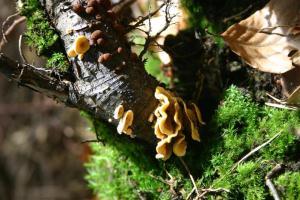
Some six years ago scientific textbooks had to be updated because of the surprising discovery made by the research group led by Frank Keppler that plants produce methane in an oxygen-rich environment.
At that time this was unthinkable, since it was commonly accepted that biogenic methane could only be formed during the decomposition of organic material under strictly anoxic conditions.
His group has now made another fascinating new observation: fungi produce methane.
Methane is 25 times more effective as a greenhouse gas when compared with carbon dioxide. Thus, it contributes significantly to climate change. It is alarming that the concentration of methane in the atmosphere has now almost tripled compared with the state before industrialization.
Most methane is produced by bacteria in rice fields, landfills or cattle farming. Following the study of Frank Keppler and his colleagues in 2006 which reported that plants also produce methane, his research team has continued to focus on methane sources. Now Katharina Lenhart, a member of Frank Keppler"s research group at the Max Planck Institute for Chemistry, has made another interesting discovery. She discovered that fungi, which decompose dead organic matter, also emit methane.
In her study, the biologist examined eight different Basidiomycetes fungi. Under laboratory conditions she observed methane production and verified her finding using isotopic labelled substrates. During her experiments she varied the culture media on which the fungi grew and found that the underlying substrate has an impact on the amount of methane formed. Various molecular, biological and analytical methods, in collaborative work with the University of Giessen and the Helmholtz Centre for Environmental Research in Magdeburg, showed that no methanogenic microorganisms (called archaea) - which produce methane in their energy metabolism - were involved. "Thus, processes within the fungi must be responsible for the formation of methane," explains Katharina Lenhart. As yet which processes these are remains unknown.
"When compared to other well-known methane sources, the amount of methane released by fungi is rather low. Their contribution to global warming is therefore classified as negligible," says Frank Keppler. Of great scientific interest, however, is the ecological relevance of these results, especially since fungi are in some instances closely associated with bacteria. Many bacteria utilize the energy-rich methane in their metabolism. They absorb methane and oxidize it to water and carbon dioxide. Currently unknown is the extent to which the methane released by fungi is absorbed by these associated bacteria or whether they benefit directly from it, concludes the biologist Katharina Lenhart.
This work is a solid foundation for follow up studies by interdisciplinary research teams to provide the explanation as to why fungi emit methane to their environment.
[AR]
Further Information:
Katharina Lenhart, Michael Bunge, Stefan Ratering, Thomas R. Neu, Ina Schüttmann, Markus Greule, Claudia Kammann, Sylvia Schnell, Christoph Müller, Holger Zorn, and Frank Keppler:
Evidence for methane production by saprotrophic fungi.
In: Nature Communications; published online 04 September 2012, DOI 10.1038/ncomms2049
Source: Max Planck Institute for Chemistry, Mainz, Germany
Last update: 05.09.2012
Perma link: https://www.internetchemistry.com/news/2012/sep12/fungi-methane.php
More chemistry: index | chemicals | lab equipment | job vacancies | sitemap
Internetchemistry: home | about | contact | imprint | privacy
© 1996 - 2023 Internetchemistry
